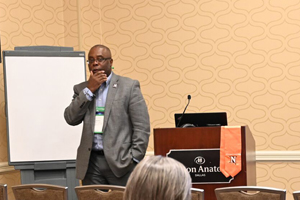
At a Monday afternoon session at AACRAO’s 2019 SEM Conference, Sedgwick Harris of Northampton Community College shared his school's student athlete academic success model. Harris, who is a former community college student athlete,
said, “This is a very unique population of students who need resources, too.”
Harris studied the institutional data of 163 NCC student athletes (male and female) and found that they were graduating at lower rates (9 percent), on average, compared to non-student athletes at the college (18 percent) and community college students
across the state (14 percent).
The objectives of NCC’s new pilot program for student athlete success included:
- increase graduation rate by 10 percent
- increase persistence rate fall to spring by 5 percent
- increase retention rate fall to fall by 5 percent
- track and monitor transfer rate
- track and monitor tutoring hours
- increase overall GPA to 3.0 or greater
Tactics to accomplish these objectives included establishing the following:
- intake form
- mandatory athletic orientation
- mandatory advising
- champions cup
- professional development seminars
- athletic director honor roll breakfast
- academic success center
The three stages of the academic success program for athletes are:
Stage 1: Organization (formulate plan, set program duration, create program implementation timeline, establish a core team (administrator, 2 student athletes, teaching faculty, student affairs representative, non-teaching faculty), select and assign
success coaches/mentors; select peer leaders; and select student athletes.
Stage 2: Orientation that is structured specifically for student athletes and focuses on assisting students in becoming academically and socially integrated.
Stage 3: Incorporation of support programming, integration of initiatives to support academic, social and professional growth and development. Includes four elements: success coaching mentoring; student success course; academic study table; personal
and professional development seminars.
Graduation rates and GPAs, Harris noted in the presentation, are on the rise.